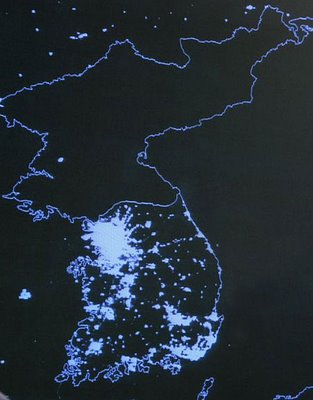North Korea might now have The Bomb, but it doesn't have much electricity:
...this picture taken one night earlier this week, is a startling contrast between the blacked-out north and the south, which is ablaze with light, particularly around major cities and the capital, Seoul, in the north-west of the country."It says it all. There's the south, the same people as the north, the same resources north and south, and the big difference is in the south it's a free political system and a free economic system.
"The people in the north are starving, their growth is stunted. It's a shame, a tragedy."
It is a tragedy. What this picture represents is very sad. I cannot imagine what the life is like for the average North Korean. In a world that has been marked by significant economic growth over the past half-century, North Korea represents what an Indian economist once told me -- "a miracle of poverty".
This simple picture is one of the best illustrations I've ever seen of the differences in outcomes between free-markets and freedom vs. a centralized command economy and dictatorship.
From 1950 to 1970, both North and South Korea's economies were on par with each other (on a GDP per capita basis). Since 1970, North Koreans have seen their real incomes drop almost in half, during which time South Korea's economy has boomed. Today, the average South Korean has over ten times the wealth of the average North Korean.
What is particularly tragic about North Korea's situation is that South Korea stands in stark contrast to what North Korea could have been with differing political and economic systems. Freedom matters.

No comments:
Post a Comment